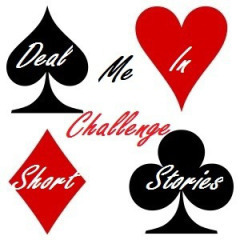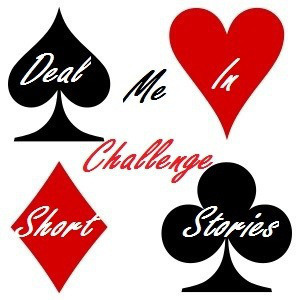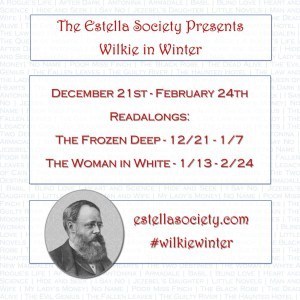Katherine Nabity's Blog, page 217
January 20, 2014
It’s Monday! What am I Reading? (1/20/14)
 Hosted by Sheila at Book Journey
Hosted by Sheila at Book Journey
It’s Monday! What Are You Reading is where we share what we read this past week, what we hope to read this week…. and anything in between! This is a great way to plan out your reading week and see what others are currently reading as well… you never know where that next “must read” book will come from!
Happy Monday Everyone!
Didn’t get a lot of reading done last week, so this week’s What Am I Reading looks a lot like last week’s.
The first third of The Woman in White is slated for discussion next Monday as part of Wilkie in Winter. I read the first two epochs last year, but I definitely need a refresher.
The Ghost of the Mary Celeste is due for release next week as well and I’d like to be timely with my review. So far, so good.
Tesla is firmly on the back burner. Thus far it’s a very systematic biography. I like that despite my lack of electrical engineering knowledge.
On the Blog
Review of Lightning coming tomorrow, sadly without the contrast of a real Tesla biography.


January 19, 2014
Things I Think About ~ Advertising
This image and an associated article, via The Huffington Post, is making its way around my corner of the internet again. It’s a 1981 advertisement for Lego blocks. This isn’t the first time I’ve seen it in the last year or two.
First, let me say, it’s a great image. I had a pretty decent Lego collection as kid. This picture could be me aside from the fact that I never had hair long enough to braid. I love the expression of pride that is being portrayed. I have absolutely no problem with the image.
…Aside from the fact that it is not a “real” image. It’s an advertisement. This little girl probably didn’t build that house and the proud grin is probably not related to that creation. It’s staged. It’s an advertisement and an advertisement that didn’t work. If it would have worked and sold Lego blocks like hot cakes to girls, boys, and their parents, this style of marketing campaign for Lego blocks would still exist.
From an anecdotal perspective, in 1981 I was the only girl I knew that had Lego blocks. Honestly, I’m not sure that many of the boys had them either, but Legos are not exactly a great thing to bring for show-and-tell. They didn’t seem to be the must-have toy in 1981. This type of advertising for this type of generic set was not selling the blocks. That is what advertising is supposed to do. Its purpose isn’t to mimic or dictate social norms. It does those things sometimes, sometimes regrettably, but that’s a side effect. The purpose of advertising is to sell product. 2014 Mad Men look at this image and see a less-than-successful ad campaign.
Is the pink-ification of girl toys selling products? I don’t know. It seems to be, otherwise it wouldn’t be so prevalent. It could be that one “pink” success has led to more brands following the trend until that’s all there is. A segment of adults wishes this weren’t the case and feels that it’s pigeon-holing girls. If it’s a bad thing, is there a way to reverse this trend? I don’t know that either. I don’t understand the trend, but I was never a very girly girl. I had more Matchbox cars than Barbie dolls. I was equally fervent about Star Wars action figures as My Little Pony. I will say that I was pretty impressed with my two nieces’ plan to pool holiday money and allowances to purchase a Lego Friends set a few Christmases ago. It was good to see them considering the cost of things even if I didn’t agree with their choice in purchases. Not my cup of tea, but who am I to judge?


January 18, 2014
Deal Me In, Week 3 ~ “The Magician of Karakosk”
Hosted by Jay @ Bibliophilopolis
“The Magician of Karakosk” by Peter S. Beagle
Card picked: Seven of Hearts
From: David Copperfield’s Beyond Imagination, ed. by David Copperfield and Janet Berliner
Review:
Once, a very long time ago, in the land I come from, there was a magician who was too good at magic.
The name of this magician is Lanak. He’s an unassuming man, a bit dumpy, and, unlike most wizards, married. He is quite happy in small out-of-the-way Karakosk, but he’s too good at what he does. His reputation draws the attention of an evil Queen who will settle for nothing less than knowing everything that Lanak knows.
Peter S. Beagle always does a magnificent job of using telling details to give his characters depth and personality. Concise details are needed when presenting a “long” short story, especially when using a very conversational voice. The set up of this story is an older, wiser man sharing a late-night tale about Lanak which is, of course, a fable about the nature and use of power. Lanak is an interesting contrast to Beagle’s more famous magician, Schmendrick. Schmendrick is tall and lank, often incompetent, and wishes for fame and grandeur. Both have to deal with the ultimate consequences of power. Generally the results are melancholic at best.
I own most of Beagle’s books, but I hadn’t read this story before. The reason for that is because it’s set in the same world as his novel The Innkeeper’s Song which I’ve been meaning to reread before I read the associated anthology, Giant Bones. This story doesn’t require knowledge of that setting, but there are mentions of things that are not of this world.
About the Author: Peter S. Beagle has been one of my favorite authors since I learned that the animated The Last Unicorn that I loved as a kid was based on a book! It was years before I tracked down a copy and read it. (What a different world it was before the internet hooked up readers with All The Books.) Despite The Last Unicorn being his most famous novel and the literary origin of Schmendrick, he’s won most of the major fantasy literature awards for other works.


January 16, 2014
Dual Review ~ The Silent Stars Go By & The Dying Days
The winter festival is approaching for the hardy colony of Morphans, but no one is in the mood to celebrate. They’re trying to build a new life on a cold new world, but each year gets harder and harder. It’s almost as if some dark force is working against them. Then three mysterious travelers arrive out of the midwinter night, one of them claiming to be a doctor. Are they bringing the gift of salvation or doom? And what else might be lurking out there, about to wake up? (via Goodreads)
Publisher: BBC Books
Publication date: 2011
Genre: Speculative fiction
Why did I choose to read this book? Previous experience with Dan Abnett.
The Dying Days by Lance Parkin
The first, last and only New Adventure to feature the Eighth Doctor. Britain is under threat of invasion by the Ice Warriors from Mars. The only people who can save the country are the Doctor, the two Brigadiers and Professor Bernice Summerfield. (via Goodreads)
Publisher: Virgin Publishing
Publication date: 1997
Genre: Speculative fiction.
Why did I choose to read this book? Wanted to read some of the Eighth Doctor’s adventures.
Two adventures featuring Ice Warriors written fourteen years and three Doctors apart. The pairing was inadvertent. I’d been meaning to read Dan Abnett’s The Silent Stars Go By since it came out and I picked The Dying Days because it was one of Eight’s first stories post-movie. Despite the common “monster,” these are two very different books written in very different circumstances.
The Dying Days is one of the first novel-length Eighth Doctor adventures to be published, but the last of Virgin Publishing’s “New Adventures” to feature the Doctor. BBC Books picked up the Doctor Who franchise later in 1997, while Virgin’s New Adventures continued, but as companion adventures featuring Bernice Summerfield. As such, The Dying Days is more of a Benny launch book, and Lance Parkins was given a good deal of leeway concerning plot and characterization. There’s a sort of experimental feel to the novel. It’s trying on a new Doctor for size, but also isn’t very connected to the franchise since it is a “final” book. Set on Earth on 1997, this is a very human-centric story with an Ice Warrior invasion wrapped in political machinations. Benny is a great, independent character. I’m not too familiar with her since she hasn’t appeared in any televised series.
The Silent Stars Go By was published in a much different climate. In the last few years, Doctor Who has arguably been at the height of its popularity. The Eleventh Doctor had a whole series behind him and Dan Abnett does a great job characterizing Eleven, Amy, and Rory. It’s easy to hear Abnett’s dialogue coming from those character’s mouths. I also liked the difference between Amy and Rory’s use of metaphors. Amy’s are fanciful and Rory’s are very down-to-earth. It’s a nice touch. The story, still involving an Ice Warrior invasion, is set on another world, one being terraformed by settlers. The Morphans have been working on their world for twenty-seven generations and their culture has gradually shifted. I really enjoyed their slang and the religion that sprung up around their work.
My main problem with both novels involves some of the more fantastical rescues and escapes. The Silent Stars Go By has an inordinate number of “saved by clothing” situations. There is an improvised escape method in The Dying Day that is so clownish and wince-worthy I had banished it from my memory and only remembered it when I checked my notes.
Variety is part of the reason that Doctor Who has been a successful franchise for so long. These two stories were very different in scope and feel, but were still, for the most part, enjoyably Doctor Who.


January 14, 2014
Review ~ Mayhem
This book was provided to me by Jo Fletcher Books via Edelweiss in exchange for an honest review.
Mayhem by Sarah Pinborough
A new killer is stalking the streets of London’s East End. Though newspapers have dubbed him ‘the Torso Killer’, this murderer’s work is overshadowed by the hysteria surrounding Jack the Ripper’s Whitechapel crimes.
The victims are women too, but their dismembered bodies, wrapped in rags and tied up with string, are pulled out of the Thames – and the heads are missing. The murderer likes to keep them. (via Goodreads)
This novel stepped into a discussion that Eric and I have been having about Jack the Ripper and his place in history. Eric wrote about the place that technology has in the coverage of the case and I’ve been musing about how law enforcement regarded the events. Were Jack’s murders truly an abomination to them? Or was it entirely a matter of media hype? With Dr. Bond, a coroner, as a main character, I repeatedly asked myself, “Would this man really be shocked?”
Whether the answer is yes or no, Pinborough does a good job with scenes of horror. She provides tense, visceral prose. Unfortunately, those scenes are few and far between. The narrative skipped back and forth in time and shifted between Dr. Bond’s first person POV and several other characters’ third person POVs. This seemed to be a method of keeping the reader off balance and artificially controlling the flow of information. It felt gimmicky to me and not needed because Pinborough has a good style.
Around halfway through the book, when James Harrington is introduced I really wished that the story were written in a linear manner, à la Dracula. That’s when it occurred to me that this book has quite a few parallels with Dracula. Both are plague allegories with an evil being brought from the old world to the new. There’s a Harker-ish traveler, a Van Helsing-like priest, an unbalanced Renfield with a strange connection to the evil they’re hunting, and Dr. Bond is very similar to Dr. Steward. The only thing missing is a strong Mina character. I had hopes for Juliana, but not much happens with her. That and the rather abrupt ending to the book left me wondering about the second book in this series, Murder. While I enjoyed Mayhem well enough, I can’t say that I’m interested in continuing.
Publisher: Jo Fletcher Books
Publication date: January 14, 2014
Genre: Horror, Historical Fiction
Why did I choose to read this book? Interested in the genre.
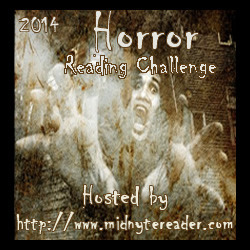
Hosted by Midnyte Reader
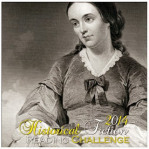
Hosted by Historical Tapestry


January 13, 2014
It’s Monday! What am I Reading? (01/13/14)
 Hosted by Sheila at Book Journey
Hosted by Sheila at Book Journey
It’s Monday! What Are You Reading is where we share what we read this past week, what we hope to read this week…. and anything in between! This is a great way to plan out your reading week and see what others are currently reading as well… you never know where that next “must read” book will come from!
Happy Monday Everyone!
Reading This Week
The Ghost of the Mary Celeste is an ARC that I’ve been looking forward to reading. I liked Valerie Martin’s Mary Reilly well enough and this mystery is compelling.
After reading two Tesla fictions, it’s time to read some non-fiction. Carlson’s book comes well-recommended.
Time to get back to The Woman in White for Wilkie in Winter.
On the Blog
Review of Mayhem coming tomorrow and reviews of two Doctor Who novels on Thursday. For the moment, Saturdays will be short story reviews for Deal Me In. I have one more book from 2013 to review, Lightning, which I plan to double up with the Tesla bio.
Unfortunately, I also have a DNF to report: Pinkerton’s Great Detective. It is an incredibly well-researched book, but it didn’t have enough narrative to keep me really interested. I need to be grounded in a story and Pinkerton’s Great Detective seemed to lose narrative thread in favor of details. Not saying this is a bad book; it just wasn’t for me at this time.


January 11, 2014
Deal Me In, Week 2 ~ “Expert Advice”
Hosted by Jay @ Bibliophilopolis
“Expert Advice” by Larry Bond
Card picked: Queen of Clubs (I’ll confess. I picked twice. My first pick was the Nine of Spades, one of my wild cards. Which would have been fine except that I really wanted to start on one of the anthologies.)
From: Tales of the Imagination, ed. by David Copperfield. Yes, that David Copperfield. When I was looking around for magic-related fiction last year, I discovered that he’d edited two mass market paperback anthologies in the 90s. Both were procured via Paperback Swap.
Review: It’s 1995 and former Army captain, Harry Connor is teaching Saddam Hussein every trick he knows…
I’ve read a teeny tiny bit of military fiction; it’s not a genre I’m terribly fond of, so this story and I didn’t get along too well. How does this relate at all to magic? A clever magician knows to take advantage of audience assumptions. People can be predictable. Military tactics even more so. That predictability can be manipulated. The story was rife with military jargon and I really didn’t get into it. Guessing which way the story was going kept me somewhat entertained.
Lesson? When I pick the wild card, take the wild cards.
About the Author: Larry Bond writes military thrillers and not many short stories. Having only read the occasional Tom Clancy novel, I was utterly unfamiliar with him.


January 9, 2014
Review ~ The Adventure of the Ectoplasmic Man
When Harry Houdini is framed and jailed for espionage, Sherlock Holmes vows to clear his name, with the two joining forces to take on blackmailers who have targeted the Prince of Wales.
It’s a case that requires all of their skills — both mental and physical. Can the daring duo solve what people are calling “The Crime of the Century”? (via Goodreads)
Originally released in 1985 as a Sherlock Holmes/Houdini mashup, The Adventure of the Ectoplasmic Man seems to have a second life as part of Titan Books’ The Further Adventures of Sherlock Holmes series. Daniel Stashower has also written three other Houdini mysteries, but these seem to be set during the magician’s early years, pre-1900. I haven’t read them, though I might.
Sherlock Holmes is by far my favorite literary detective and Houdini is, well, my twentieth favorite magician. This book should be some sort of alley of mine, right?
The story is really a Houdini showcase. There’s an extended scene of Harry Houdini escaping from being bound to a chair that is physical and tense. There are also many other nods to Houdinia: water torture cells, milk cans, airplane shenanigans, and lots and lots of handcuffs. The characterization of Holmes was pretty good too, though Holmes takes a backseat to Watson and Houdini’s relationship. Indeed, Stashower posits that Houdini has physical acuity equal to Holmes’ mental attributes.
Plot-wise, the mystery seemed overly ornate to me. Lestrade’s purpose is to be annoyingly incorrect, Watson is relied upon to be incompetent, and there are a few goose chases that are tedious. It felt padded out. The solution of the mystery was a bit of a cheat with a snippet of information held back until the end.
Not a great mystery, but not bad for this sort of famous person/famous character crossover.
Publisher: William Morrow & Company
Publication date: 1985
Genre: Mystery
Why did I choose to read this book? Another magician-involved mystery.


January 7, 2014
Wilkie in Winter ~ The Frozen Deep
 The first part of The Estella Society’s Wilkie in Winter event is a look at The Frozen Deep by Wilkie Collins and kind of, sort of Charles Dickens.
The first part of The Estella Society’s Wilkie in Winter event is a look at The Frozen Deep by Wilkie Collins and kind of, sort of Charles Dickens.
Based on the doomed 1845 expedition to the Arctic, The Frozen Deep is a dramatic tale of vengeance and self-sacrifice. Exchanging vows of love with sailor Frank Aldersley the night before his departure, Clara Burnham is haunted by the memory of Richard Wardour, and his mistaken belief that they will one day marry. On different ships, the two men have no cause to meet—until disaster strikes and they find themselves united by their battle for survival. When they learn of their rivalry, there follows an act of pure selflessness, making The Frozen Deep one of Collins’ most moving and tragic works.
Initial Impressions
(before checking out the questions at Estalla Society)
The first half of this novella definitely hits some of my sweet spots. Clara’s trances reminded me of Harwood’s The Seance and that novel’s use of second sight. I was also amused by Clara’s troubles being attributed to “secret anxieties.”
Scenes Two and Three bring to mind the framing device of Frankenstein and the first portion of the 1941 movie 49th Parallel, in which escapees from a sunken Nazi U-boat hideout in a Canadian trapping lodge. The Hut of the Sea-Mew chapters are tense, claustrophobic, and filled with doom. Not only are the majority of these characters lost, but Wardour’s prescience breeds true.
“I knew it then; I know it now–it was written on my heart then, it is written on my heart now–we two shall meet and know each other.”
There is an interesting war between superstition and religion near the end of the book. Mrs. Crayford continually admonished Clara for her “miserable superstitious faith” and urges her to trust in God. We begin to wonder if anyone can escape their destiny. In the end, it’s in Wardour’s hands.
Best quote:
“When you are married, you will know that the easiest of all secrets to keep is a secret from your husband.”
Questions
1. How do you feel about the narrative structure? The obvious rewrite of stage direction? The structure didn’t bug me although I wonder if the “Between the Scenes” scene might have been left out or maybe used as a front-of-stage scene while a ballroom and Sea-Mew hut set were changed. (Note: I know very little about stagecraft; this is pure speculation.)
2. How do you think this play looked performed? Do you think it would make more sense in that medium that in this small novella? I thought it worked pretty well as a novella, although I have been watching quite a few movies from the 30s and 40s. I kept seeing The Frozen Deep in that sort of stationary camera work and melodramatic dialogue.
3. What did you think of the “love triangle?” Did it feel forced? Which man would you have picked? I was somewhat annoyed at Clara for not being completely clear to Wardour about her intentions from the beginning. (Obviously, keeping quiet on the matter worked so much better.) I’m never a fan of drama caused by non-communication. I would have picked Aldersley, but hit him upside the head for wanting to go on an Arctic expedition. I suppose that shows my modern sensibilities.
4. Impressions of Clara and her characterization? Oh, Clara. Perhaps I can understand Clara a little bit having been in a similar situation. She doesn’t want to marry Wardour, but only gets around to telling him so in a letter and, when she doesn’t hear from him, hopes he never returns. When he dose return, that’s when I feel Clara should be more resolute and come clean about her fondness for Aldersley.
5. Supposedly Dickens had a hand in helping write this script. Can you feel his hand in the writing? How much was Dickens and how much was Collins? I haven’t read enough Dickens or Wilkie yet to suss out one from the other.
More Winkie In Winter discussion can be found on the link-up page!







